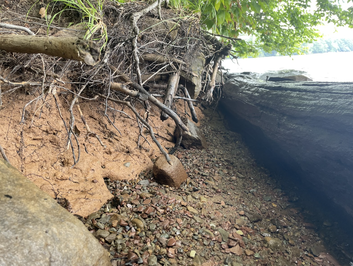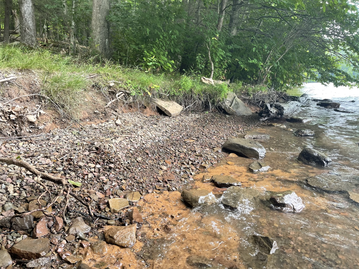|
Lakes are tightly connected to their watersheds, the area that drain into the lake. Rain and snow flow over and through the soil into lakes, bringing important dissolved and particulate materials. Animals and plants that use the water and the land transport energy and materials between the two environments as well.
Lakes have been described as sentinels of change due to their sensitivity to activities within their watersheds and the integrity of the watershed is vitally important to the health of a lake. Riparian areas, or the area near the shoreline, can be particularly important. Riparian vegetation can stabilize shore lines, reduce nutrient inputs, and help provide habitat complexity for lake and terrestrial wildlife. |
Drone footage of the western "boggy" shore of Lake Lacawac. Video by Roger Thomas of the Academy of Natural Sciences at Drexel University.
|
Lake Lacawac's watershed is protected from development, logging, and other human impacts. The western side of the lake is bordered by a bog while the eastern side is bordered by mixed hardwood forest.
Some common riparian issues...
Erosion
Shoreline erosion occurs when the land at the lake’s edge is degraded and collapses. This can be caused by high wave energy as well as excessive runoff. Sedimentation carries nutrients and other pollutants attached to the soil into the lake. Soil erosion can contribute to nutrient enrichment, decreased water clarity, and habitat loss. Shorelines without adequate riparian vegetation and/or that experience high wave energy tend to be more vulnerable to erosion.
Shoreline erosion occurs when the land at the lake’s edge is degraded and collapses. This can be caused by high wave energy as well as excessive runoff. Sedimentation carries nutrients and other pollutants attached to the soil into the lake. Soil erosion can contribute to nutrient enrichment, decreased water clarity, and habitat loss. Shorelines without adequate riparian vegetation and/or that experience high wave energy tend to be more vulnerable to erosion.
Examples of shoreline erosion from Lake Wallenpaupack (visible from Lacawac's Big Lake Trail).
Runoff
Surface occurs when precipitation flows over impervious surfaces such as driveways, parking areas, roofs, or saturated soils and ends up in the lake. As the runoff flows to the lake, it picks up pollutants along the way such as pesticides, metals, excess nutrients, or litter. Runoff from agricultural areas can be particularly rich in fertilizers and pesticides.
Surface occurs when precipitation flows over impervious surfaces such as driveways, parking areas, roofs, or saturated soils and ends up in the lake. As the runoff flows to the lake, it picks up pollutants along the way such as pesticides, metals, excess nutrients, or litter. Runoff from agricultural areas can be particularly rich in fertilizers and pesticides.
Point Sources
The United States Environmental Protection agency defines a point source as “any discernible, confined and discrete conveyance, including but not limited to any pipe, ditch, channel, tunnel, conduit, well, discrete fissure, container, rolling stock, concentrated animal feeding operation, or vessel or other floating craft, from which pollutants are or may be discharged.” Point sources are (relatively) easy to identify and come from a single place such as municipal wastewater treatments plants to leaky septic systems. Once a point source is identified, it is important to immediately stop the pollutant from further emission when possible.
The United States Environmental Protection agency defines a point source as “any discernible, confined and discrete conveyance, including but not limited to any pipe, ditch, channel, tunnel, conduit, well, discrete fissure, container, rolling stock, concentrated animal feeding operation, or vessel or other floating craft, from which pollutants are or may be discharged.” Point sources are (relatively) easy to identify and come from a single place such as municipal wastewater treatments plants to leaky septic systems. Once a point source is identified, it is important to immediately stop the pollutant from further emission when possible.
How to preserve and repair riparian areas
A healthy, diverse, and resilient riparian plant community can help mitigate many shoreline issues. Consider increasing native vegetation cover. Plant roots are the most natural way to maintain a shoreline. There are a range of bioengineering techniques that can help address shoreline issues as well. The Pennsylvania Lake Management Society (PALMS) has several resources and even funding opportunities to help lake communities maintain and protect their lakes.
Location |
|

